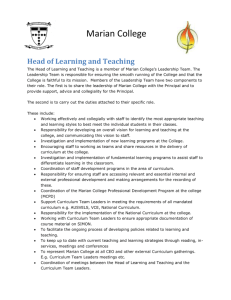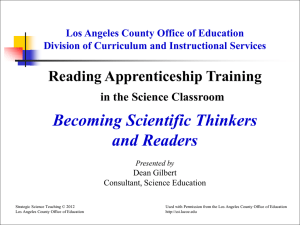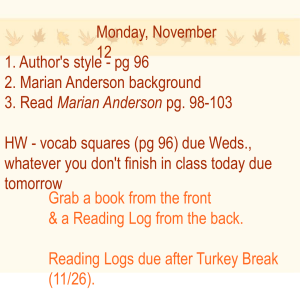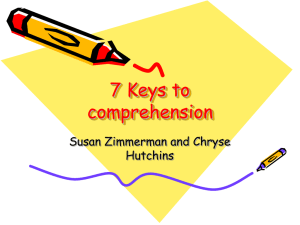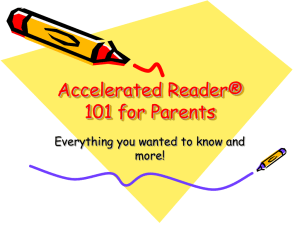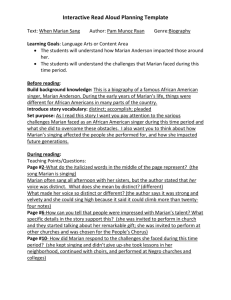English Midterm - Blogs @ Butler
advertisement
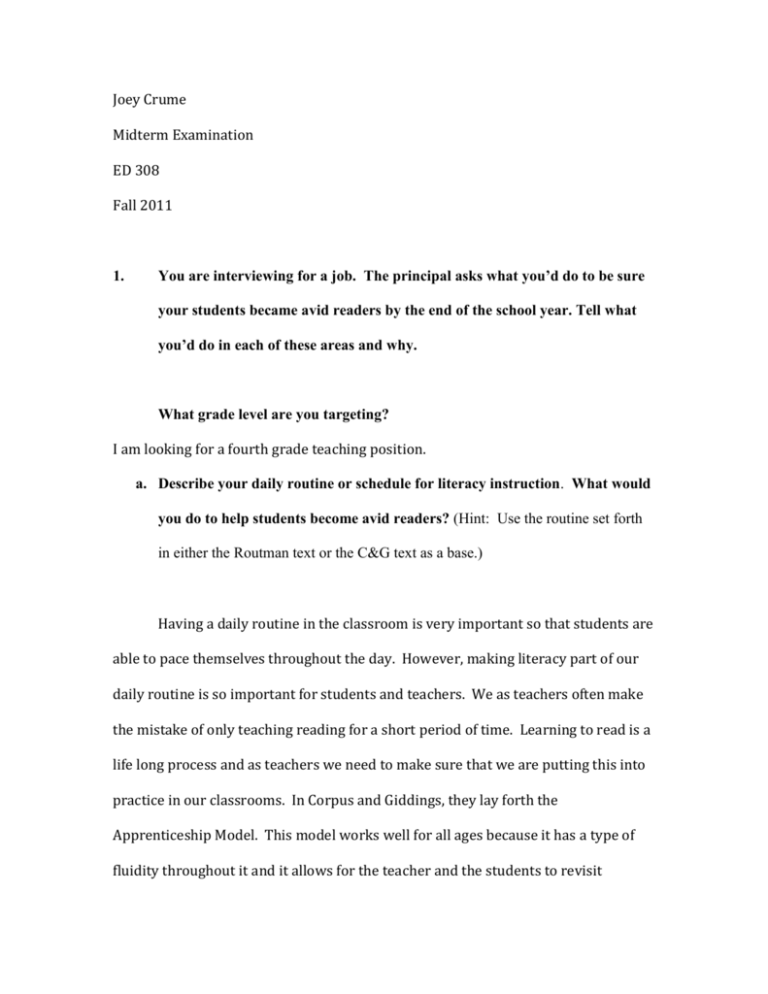
Joey Crume Midterm Examination ED 308 Fall 2011 1. You are interviewing for a job. The principal asks what you’d do to be sure your students became avid readers by the end of the school year. Tell what you’d do in each of these areas and why. What grade level are you targeting? I am looking for a fourth grade teaching position. a. Describe your daily routine or schedule for literacy instruction. What would you do to help students become avid readers? (Hint: Use the routine set forth in either the Routman text or the C&G text as a base.) Having a daily routine in the classroom is very important so that students are able to pace themselves throughout the day. However, making literacy part of our daily routine is so important for students and teachers. We as teachers often make the mistake of only teaching reading for a short period of time. Learning to read is a life long process and as teachers we need to make sure that we are putting this into practice in our classrooms. In Corpus and Giddings, they lay forth the Apprenticeship Model. This model works well for all ages because it has a type of fluidity throughout it and it allows for the teacher and the students to revisit different steps when need be. The apprenticeship model begins with a model demonstration by the teacher then followed by shared practice, guided practice then finally, independent practice. For the apprenticeship model to work, I as the teacher need to be very specific about my teaching point and which strategies I’m using. When modeling I would make sure to say what my wonders, predictions, and other questions are. Showing the students how to record their thoughts is also very important so that students are able to translate what they have been shown into their own work. As we continue to read I would stop at words that the students might struggle with and show them how to chunk a word, reread if something does not make sense, and how to ask a friend if they might know what a word means. After I finish the read aloud portion, I would guide my students into shared practice. This is the part of the Apprenticeship Model that can be one of the hardest ones to achieve. Having the students tell you what should be done and helping you through the reading process. This allows me as the teacher to see what my students are gathering about the reading strategies and what they are still struggling with. After this, students will break off into small groups for the guided reading practice. When students break off into small groups, it is important that students are focused on a particular strategy that they are working on for the day. They can/should be using their other strategies but they are focused on improving a particular one. During the guided practice the teacher is close by to affirm the students work and monitor their process. If need be the teacher can step back into the shared practice or modeling to help the students in the model. Finally, the students move into independent practice. Independent practice is a time where students are broken up into groups based on a plethora of different reasons. Sometimes students will be grouped because they are reading similar books or of a same interest topic, sometimes students are broken into groups because of their skill set and all the members in the group offer something different and therefore they complete each other and support each other, and other times students can pick partners to read with because reading is a very social activity. Students have worked with the model and can practice on their own. The teacher is listening and watching but not overseeing the students in an obtrusive form. This way if the teacher feels it necessary to step back into teacher model she can but the goal is that students are effectively efficient on their own. Also during this time, I can be listening in on their conversations and recording notes about what strategies they are working on, which ones they are proficient and where they need some more support. In the Apprenticeship Model, it is important that when moving from the different phases of modeling that the students have time to finish their thoughts and ideas before moving onto the next part of the model. Too often students are interrupted and they loose their train of thought and it can hinder their learning. The writing portion of the Apprenticeship Model can be incorporated in several different ways. Part of the effectiveness of this model is that it teaches students how to be good readers for life. Post its are a teacher’s best friend and a students as well. Making predictions, asking questions, inferences, and other types of reading strategies are a great tool for tracking our reading. This is also one way for a teacher to assess what her students are learning. One thing I would encourage my students to do would be to keep a reading journal. This can be either a physical hand written journal or an electronic journal where students record their thoughts and ideas in throughout a reading. I as the teacher can assess what the student is gathering from their readings, what I can model and work with them on, and where their strengths lie. As I have already stated, assessment can take form by observing and evaluating students’ work. It can also take form from the listening of students read and their process of reading based upon their notes and such. When students interact with a text, it gives huge insight to what they are seeing and experiencing, especially when they are making connections and recording this. It also helps teachers to see when students are not interacting and are withdrawn from a text because it shows that the student is not engaged. As the teacher, I need to find a way to engage the student and then work with them and we together can enjoy reading. Why would you do these things? In your explanation, 1) be sure to refer to models of reading and/or theories about learning; 2) give specific examples based on your experiences in this practicum or in your enrichment work; 3) use your textbooks as a resource and attribute those ideas to the appropriate author(s) including page numbers. I think the modeling apprenticeship is so important because it allows the teacher the flexibility and creativity to tailor to the students and their needs. So often we see reading as a one size fits all, cookie cutter approach. Unfortunately children are not one size fits all and therefore this cannot possibly work. We have created a nation of fast readers who loathe books and can comprehend the words on the page just about as well as the nonsense words they were expected to read for standardized tests. Reading is more than being able to decode words on a page. It is an interconnected work of art. When we read we are using syntax, visuals and meaning (class notes August 31, 2011). We also talked a great deal in not only this class but also the reading class about ZPD and focusing instruction based on each child’s needs and where the threshold is for their learning. On page 15 in Corpus and Giddings, “The teacher/student interaction within the ZPD extends what the student can do without help and shifts the area of learning toward more challenging skills and strategies. That successful interaction also fosters a student’s confidence and willingness to keep from trying and learning. The apprentice can see himself or herself as a craftsperson someday.” This is so incredibly valuable and important because we want students to be strong readers who can enjoy reading. Working within a student’s ZPD and using their schema allows for stronger connections and a longer relationship with reading. I found that sometimes it is difficult, though, to find the threshold within the ZPD when students had little background knowledge. In our enrichment setting, my partner and I had planned an entire series based on the students knowing about the solar system. When we met our students, they knew the planets in the solar system but not much beyond that. Trying to find our teaching point was rather difficult and we had to redo our series because our students’ ZPD would have been beyond the frustration point. The classroom I’m in the students are focused on reading strategies and instruction. Each student has received a bookmark with many different reading strategies to be used as reference. Many of the students that I work with will use phrases such as, “I’m predicting….” or “I’m wondering…” or “I’m making a text to text connection…”. The students in the class are really becoming much stronger readers and are connecting with reading differently than students that I have worked with before who absolutely loathe to read. One thing I would do differently in my own classroom would be to incorporate reading across the curriculum. In class we have talked a great deal of teaching reading through a variety of subjects because so often social studies or science are left out of classrooms. The other thing I would like to integrate would be social reading. Students who have a support system with each other make for stronger readers and scholars. Routman talks about the social aspects of reading and how students can actually lean from each other. “Partnered reading is an excellent way for students to rely on each other more and more self sufficient readers” (Routman pg 91). In my own classroom, I would like to have this system where students are able to practice their reading strategies and comprehend together. b. Give an example of a reading lesson you would teach at your grade level using Routman’s Optimal Learning Model or the C&G Apprenticeship Model. (Use as your sources for ideas your Routman and C&G texts, the demonstrations in our class based on the read-alouds, or examples you’ve seen in your classroom.) Your lesson does not have to contain each level of the Optimal Learning Model, but if it doesn’t, you’ll need to give a brief description of what you would do to lead up to or to build upon the lesson you do present. (For example, your lesson may really be the guided portion of the Optimal Learning Model in which the teacher is doing and the children are helping. Explain what you did to model or demonstrate before the lesson. Tell what you’ll do next to guide the students as they do the work.) Lesson: When Marian Sang Purpose: I would use this book during Black History Month. Marian Anderson is one of the many unsung heroes who helped pave way for the Civil Rights movement. I want my students to experience her story and make connections to her story. This lesson will build on their schema of the difficulty African Americans faced after slavery and before equal rights. Materials: When Marian Sang by Pam Munoz Ryan Sticky Notes for making connections- text to text, text to self, or text to world. State Standards: History: 4.1.9 The Civil War Era and Later Development 4.1.17 Chronological Thinking, Historical Comprehension, Analysis and Interpretation, Research. English: 4.7.7 Emphasize points in ways that help the listener or viewer follow important ideas and concepts. 4.2.2 Analysis of grade-level-appropriate nonfiction and informational text: use appropriate strategies when reading for different purposes. Procedure: Before I start reading, I will ask the students to get with their social studies reading buddy. I want them to turn and talk about what they remember from previous stories about the hardships of African Americans. I will model and share that I can make a text to world connection because I know that during the 1920’s African Americans in the US were treated as less than white people and in some areas of the country it is still that way. I will also tell the students that there are many great famous songs that are in the book and if they would like recite the words with me as I read, they are more than welcome to- this is making a text to self connection. During Reading: o I will ask if any of the children have heard great choir music or sing in a choir and to visualize how that feels. o On the page where Marian is denied access to the music school I will have the students think, pair, share about why she was not allowed to go. Each student will get 2 minutes to talk and then each group can share with the class what their thoughts were. After the students share, we will have a mini discussion as to what was going on during this time period- after civil war but before civil rights. o I will give the students background information on Boghetti, seeing that most of them have probably not heard of him. Then I will ask the students to turn and talk about what Marian might have been feeling singing for him. I would ask questions like, “have you ever done something that you were really afraid of doing? “What did that feel like?” This way they are making the text to self-connections. Then I will have the students make predictions about what will happen after Marian sings for Boghetti. o When we get to the page where Marian is not allowed to sing in DC I will have some of the students give reasons as to why she should be allowed to sing and some who will give reasons as to why she shouldn’t. Then I will ask the students to write a letter in petition to let Marian sing. This will also help students in the comprehension and analysis of what was going on during this time period. After Reading: o When we finish the book, I’ll have students write in their reading journals for about 5-8 minutes about their thoughts and feelings. Is Marian’s story worth telling and passing along or is it not that important and why? What connections they have made to her story or questions they still might have? Then I will have the students group with about 4 kids per group and they will write a letter of why Marian’s story should or should not be retold. Assessment: o I will assess my students based on their conversations with each other as to whether or not they are connection to the story and their comprehension of the meaning of the story. o I will also assess students on their letters of petition in regards to analysis and comprehension of the character they would be portraying. As a side note on these assessments, these would be informal unless otherwise noted. Therefore, spelling and grammar would not be graded. 2a. Write a clear, succinct statement of beliefs about the teaching of reading based on the model and approaches presented in class lectures and in your textbooks. Focus specifically on the roles of phonics, vocabulary, fluency, and comprehension instruction in grades 3-6. Be sure to use both information from your textbooks and examples from your experiences at Central Elementary in the classrooms and/or in the enrichment setting. Clearly cite references to your textbooks by authors’ names and page numbers. Cite information from your lecture notes by date. This document should not exceed two pages in length. I believe that all students can read and need to be able to successful as readers. It is my job as a professional to ensure that my students are equipped with as many strategies and supports to ensure their success. One of our introductory classes on August 31st presented the idea of the Constructionist theory for reading where good readers are using visuals, syntax, and meaning to have a well-rounded reading. I believe this theory along with the Apprenticeship model outlined in Corpus and Giddings prepares students for a successful and rich life with reading. This model and theory also allows for the teacher hone in on the student’s needs and strengths, therefore enhancing their educational experience. Routman says on page 128 that the definition of fluency is, “the ability to read a text quickly, accurately, and with proper expression. I find this definition inadequate because fluency without comprehension is not reading it is word calling.” I think that so often we as teachers we forget the comprehension component reading and make it into a separate entity. Comprehension is stressed just as much as the other parts of reading in the Constructionist theory and therefore makes a complete reader. In my enrichment work and my work in the classroom, I’m seeing students who are being forced to read certain books. We are doing a huge disservice to these students. Reading should not be a chore but rather a means to grow and develop. I believe that if we teach students deeper meaning, work off of their ZPD’s and background knowledge then we will be able to not only raise standardized test scores but also help students be critical thinkers, who question and wonder, and are responsive to the world around them. 2b. Choose a grade level and two instructional strategies from class lectures that you have not yet used in your midterm. Clearly explain how you would use each strategy in your classroom (use examples) and why each is appropriate at that age level. Then explain why these strategies as you have explained them are based on the beliefs about reading from section 2a. For fifth graders, having the students use an Alphachart can be a very handy tool for students to keep track of their reading and information in their unit. We can use Alphacharts for nearly any subject. One subject we could use it for would be in science if we are studying plant cells, the students can keep track of their notes A-Z in their words. I would model the Alphachart for my students so they would know how to effectively use it. Students could also use it in their studies or on tests to help them demonstrate their knowledge and understanding. Alphacharts should only be used after modeling what they are and only when students are using their language so it makes sense to them. Another strategy I think is highly effective strategy especially in social studies is the hot seat. This Desert Island strategy asks students to take on the persona and embody a particular person and then are asked questions about why they did what they did. This gets students thinking about real people. I would probably help demonstrate this strategy by having either a former student or other teachers come in and have them help me model what being in the hot seat is and probably towards the end of first semester I would have my students try independent practice with it.
